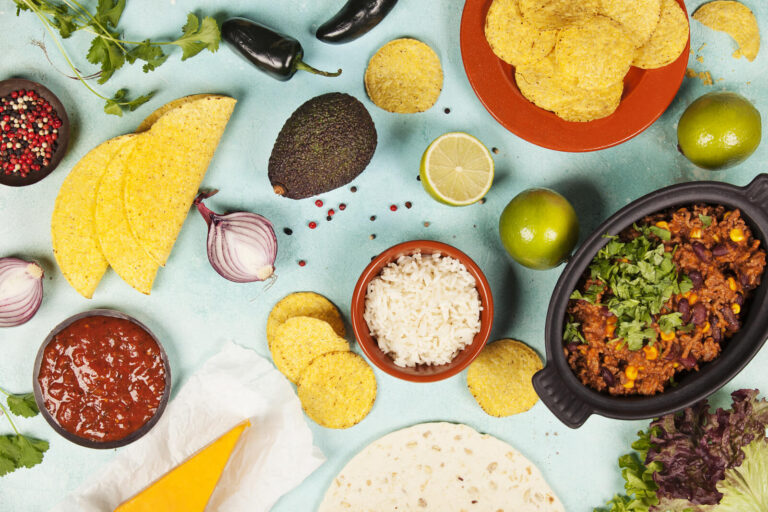31 Tips for Cutting Your Grocery Bill

You may think there’s not much you can do about the high cost of groceries. After all, we all have to eat!
But the truth is, there are a number of relatively easy ways to slash your weekly spending on groceries. And, saving at the supermarket doesn’t have to mean skimping on taste, quality, or nutrition.
What follows are 31 simple tricks that can help you shop smarter and spend less every time you hit the supermarket.
Tips for Grocery Shopping on a Budget
1. Making–and Sticking to–a List
Impulse buys can quickly bust your budget. So before going to the supermarket it can be wise to plan out your meals and make a detailed list of all the things you will need, including any household supplies.
At the store, you’ll want to be strict about sticking to the list. Yes, those pineapples look great and they’re on sale, but are they on your list? No? Then you should probably keep walking.
Shopping with a list not only helps save money but can also cut down on food waste–the items that tend to sit idle in the fridge or on the countertop are often the ones that never had an assigned meal, to begin with.
Sticking to a shopping list can save money as well as food waste.
2. Eating Before You Go
If you enter a supermarket hungry, there’s no telling what you’ll end up putting into your cart because, since just about everything is going to look good.
Walk into the grocery store with a full stomach, on the other hand, and you might be shocked by how much lower your grocery bill is.
3. Planning for Leftovers
According to a study by Bosch home appliances , the average American tosses $53.81 worth of spoiled food a week from their refrigerator, or $2,798 every year.
One reason that food goes to waste is that it can be difficult to buy the exact amount of food you need to make the meals we’ve planned. This can result in leftover ingredients languishing in the fridge or pantry, and then landing in the trash can.
You can help reduce wasted food (and money) by doubling your recipe and then having leftovers for lunch and/or putting some in the freezer so you’ll have a meal at the ready when you need it.
4. Grocery Shopping Online
Think you’ll be tempted to go off-script if you enter a grocery store? You might want to try online grocery shopping instead. Many local supermarkets offer online ordering, and allow you to choose either curbside pick-up or delivery.
Or, you may want to try one of the many online grocery services, such as Peapod, Instacart, or Amazon Fresh. You can often choose one-off delivery, as well as recurring delivery of staples (like toilet paper) so you never run out.
It can be easier to avoid the temptations when you can type everything you need into a search bar. Plus, shopping online makes it easy to compare brand prices, see what’s on sale, and watch the total tally up in real time.
5. Developing a Green Thumb
Even if you’re not much of a gardener, you might want to try growing one or two of your favorite vegetables in a container or a small garden area outdoors. You can then step outside and pick your tomato or bell pepper rather than buying them at the store.
If you don’t have any outdoor space, you might consider starting an indoor herb garden. If you have parsley, basil, or cilantro right on your windowsill, you can just pick what you need rather than buy a whole bunch at the market.
6. Sticking to Stores You Know
Having a tried and true grocery store may be good for your wallet. Walking into a store you’re familiar with means you already know where to get the items on your list.
Head into an unfamiliar store and you may be left wandering the aisles for what seems like an eternity trying to find your goods.
That’s because grocery stores are set up to be a little confusing and to drive consumers to have to do a bit of wandering, as that’s when you’re more likely to make random purchases.
7. Bringing Your Own Bags
One quick way to potentially drive down the cost of your grocery store run is to BYOB—bring your own bags. Many stores now reward customers who bring reusable bags by reimbursing them about 5 to 10 cents a bag at checkout.
It may feel like a small financial transaction, but it’ll add up over time–and it’s also kinder to the environment. Keeping some reusable bags in your car is a good way to avoid forgetting them at home.
8. Joining Loyalty Programs
Many stores now offer discounts for regular shoppers and even secret sale items only for those who’ve signed up.
It’s typically quick, easy, and free to join, though some stores like Whole Foods require customers to be part of its Amazon Prime membership service (which comes with a yearly fee). Still, it may be worth it as discounts at the register can add up to real savings.
9. Embracing Meatless Mondays
Reducing meat consumption and eating more plant-based meals has benefits for the environment, your waistline, and your wallet.
Chickpeas, black beans, peas, brussel sprouts, quinoa, tofu, along with many other beans, whole grains, and vegetables are all excellent (and inexpensive) sources of protein without the added saturated fat that comes with animal products.
You may want to consider going meatless at least one day a week, and then building up to a few meat-free meals per week.
10. Buying Larger Containers
Buying the largest size of packaged, canned, and frozen foods can sometimes help you save money on food. That’s because some of the cost of every grocery item is in the packaging.
If your grocery store has a “bulk foods” section you might save even more by buying the amount of food you need to place into plastic bags.
11. Thinking Beyond Fresh Produce
Another way to save money at the grocery store is to buy fruits and vegetables in the frozen or canned foods aisle. The savings can add up, especially when the food is out of season.
If you’re looking to add pineapple to a recipe in the winter, you can save money by opting for canned pineapple over a fresh one that’s not in season. Canned and frozen fruits and vegetables also don’t go bad as quickly as fresh, so they may be less likely to get wasted.
12. Trying a CSA
A Community-Supported Agriculture (CSA) program can help you save money on fresh produce, eggs, and herbs. You can look for one using the USDA’s CSA directory and see if they’ll deliver to your front door.
Not only will you be saving money but you’ll be supporting local farmers and eating food that’s close by helps ensure it’s fresher.
13. Clipping Coupons
While it’s not rocket science, this tried-and-true technique is still one of the best ways to cut your grocery bill. You may want to consider scanning the local circulars that come in the mail to see which stores are having deals on the food items you need that week.
You can also look for manufacturers’ coupons (often in circulars inserted into Sunday newspapers), clip them, and store them in your wallet.
When it comes to couponing, however, it’s wise to make sure that you’re only buying items you need and usually buy–otherwise you could end up adding to, not shrinking, your grocery bill.
14. Shopping in Season
It’s typically cheaper to buy fruits and vegetables that are in season than ones that have been shipped to the store from a far-away place where it can be grown year-round.
Also, since in-season produce is in large supply, it tends to be sold at affordable prices to maintain demand. In-season produce also tends to be tastier.
15. Using Apps
There are a number of rebate apps you can download onto your phone for free that allow you to get cashback on items you purchased. Options include Ibotta, SnipSnap, Saving Star, Coupon Sherpa, and Checkout 51, and Fetch Rewards.
While rebates don’t give you a discount upfront (like a traditional coupon), you should see savings in the long run.
If you frequently shop at large chains like Walmart or Target for groceries, getting their apps may help you earn rewards and get discounts for being a loyal shopper. You just need to scan your mobile app when you check out.
16. Stocking up on Shelf-Stable Items
When your grocery store is having a sale on canned goods, dried goods, or other pantry items, you may want to consider buying multiples. Items like beans, sauces, soups, nuts, peanut butter, pretzels, shelf-stable snacks like unpopped popcorn won’t expire for a long time.
You’ll be able to enjoy the cost savings and will likely appreciate having them on hand when preparing meals.
17. Buying Store-Brand or Generic
You don’t have to sacrifice flavor and taste in order to save money while grocery shopping. While It’s easy to overlook no-name or store brands, in many cases these items are actually made by the brand name companies, just with a different label.
And the savings can be real. Preparing dinner using generic (rather than brand name) products can save as much as $20 a week–or $80 a month.
18. Shopping the Outside Aisles
The inside aisles of the grocery store are where pricier processed foods are typically stocked, The outer edges, on the other hand, is where you tend to find fresh fruits and vegetables, grains and beans.
Shopping on the edge–and filling your cart with nutrient-dense items and fresh, seasonal food–can help your wallet, as well as your waistline.
19. Portioning Food Out Yourself
It can be tempting to buy convenience items where food is pre-portioned into single servings so you can just grab-and-go. Smaller items can also help you keep from overeating. But all of that packaging tends to increase the cost of the item.
If your kids love crackers, you may want to buy a full-size box and portion them out in zip-top bags or reusable containers. You can do the same with other favorite snacks so you won’t be tempted to eat the whole bag in one sitting. You can also spoon yogurt into small containers for school and cut cheese into slices from a block for easy snacks.
20. Drinking Tap Water
To avoid spending money on bottled water, you may want to get a filtered pitcher and switch to drinking tap water. By drinking from a reusable water bottle or a glass throughout the day, you’ll also reduce the amount of plastic waste you’re putting into the environment
Getting your kids used to drinking water instead of juice or soda can also reduce your supermarket bills.
21. Using a Smaller Cart
If you’re not shopping for a full week’s worth of groceries, consider grabbing a small cart or, even better, a hand-held basket. This will automatically limit how much you can buy because only so much will fit.
When you have a smaller cart–or a basket that will get heavy quickly–you’re forcing yourself to ask, “Do I really need this?” every time you pick up something to buy in the store.
22. Minimizing Trips to the Store
One way you can save money on your grocery bill is to only shop when you need to and to minimize the frequency that you set foot in the supermarket door.
The reason is that the less often you’re physically in the store, the less likely you’ll be tempted to buy something you don’t absolutely need. It can be all too common to go to the grocery store for “one thing” and come out with a few items.
23. Shopping Off-Peak
Most of us don’t want to spend our weekends grocery shopping, right? Unfortunately, Saturdays and Sundays are the days when many of us have the time to go to the supermarket–along with everyone else in our town.
Shopping during peak times can hurt your budget in a few ways. You might try to speed through the supermarket and be more likely to buy an item at the end of the aisle because it’s convenient, rather than grab a similar product on the shelf a few feet away. This could mean they are buying a more expensive version of what they need.
You might also run into trouble shopping during peak times because you’re more likely to get stuck in a long line–and become tempted by miscellaneous items stocked near and along the checkout line.
24. Calculating the Bill While you Shop
Shopping with a calculator or getting out your phone and adding things up as you put them in your cart can help you stick to your spending plan. (If you’re shopping with kids, you can give them the job to tally what’s in the cart.)
By keeping a running tally of how much money is in your cart, you can save yourself from any unpleasant surprises during check-out. Plus, it can make you think twice before putting any extras in your cart.
25. Shopping Your Pantry First
It’s easy to accidentally buy an extra item at the supermarket that you didn’t realize you already had stored at home. That’s why after you write your grocery list, it can be a good idea to double-check pantry shelves, spice racks, the fridge, and the freezer to make sure you truly need what’s on your list.
You may even want to shop your pantry and fridge before making your meal plan and shopping list to see if you can think of meals that incorporate foods you already have on hand.
26. Paying with Cash
A simple trick for lowering your grocery bill is to set your budget and then only bring that much money in cash, leaving the plastic at home.
This will help ensure that you stick to your list and avoid grabbing any tempting extras. You can only spend what you have in your wallet. Full stop.
27. Making Breakfast for Dinner
Eggs are one of the most affordable protein sources out there. By making simple breakfast-style food for dinner, you’re offering your family a fun meal and using up some of your (affordable) breakfast foods.
You might consider making an omelet or frittata with eggs, cheese, and leftover vegetables, whipping up blueberry pancakes, or creating a bacon, egg, and cheese burrito. Not only are many breakfast recipes a delicious dinner option, but they’re affordable and often quick to prepare.
28. Avoiding Eye-Level Items
Grocery stores are designed to get you to spend more money, which is why the most expensive products tend to be stocked at eye level. Brands often pay more money for their products to be displayed prominently so you’re more likely to buy them.
Searching high and low when you’re shopping may yield significant savings. Once you start looking, you may even notice a price differential between the eye-level item cost and the one at your feet.
29. Baking Your Own Treats
Many impulse buys happen in the bakery and snack sections of the supermarket. Before you succumb, you may want to ask yourself if you could bake it at home. You may already have the baking basics on your pantry shelves and could whip up some muffin or cookies fairly quickly. Or, you might want to buy a mix to save time (you’ll still save money).
Before buying chips and snacks, you may also want to consider if there is a more affordable DIY option, like buying popcorn kernels to cook on the stove.
Asking yourself, “Can I make this?” will likely result in saving money and getting the freshest item possible.
30. Hitting the Store on a Wednesday
When it comes to snagging good deals, shopping on a Wednesday may be beneficial. That’s because grocery stores tend to restock their shelves and make new mark-downs in the middle of the week. Since they’re in the process of changing the discounts, they may still honor the price cuts from last week’s sale as well as the new ones.
31. Doing the Prep Work Yourself
Those packaged baby carrots and bagged pre-washed salads make it easier to eat healthier, but if you’re willing to do the cleaning, prepping and chopping of fresh produce, and even meats and poultry, you can save money.
A boneless, skinless chicken breast package will cost more than buying a whole chicken. You’re paying for the convenience. By setting aside time to prep and chop your foods after you get home from grocery shopping, you’ll likely reap savings.
The Takeaway
A little planning and knowing some money-saving tricks can help you lower your monthly grocery bill and stick to your budget.
By following these budget shopping tips, you may find that you have more money left over each month to pay down debt, invest for the future, or save for something fun.
Looking for a good place to put your newfound savings? You might want to consider SoFi Money®. SoFi Money is a cash management account that allows you to separate your spending from your savings while earning competitive interest on all your money.
Disclaimers
SoFi Money®
SoFi Money is a cash management account, which is a brokerage product, offered by SoFi Securities LLC, member FINRA / SIPC . Neither SoFi nor its affiliates is a bank. SoFi Money Debit Card issued by The Bancorp Bank. SoFi has partnered with Allpoint to provide consumers with ATM access at any of the 55,000+ ATMs within the Allpoint network. Consumers will not be charged a fee when using an in-network ATM, however, third party fees incurred when using out-of-network ATMs are not subject to reimbursement. SoFi’s ATM policies are subject to change at our discretion at any time.
Third Party Brand Mentions: No brands or products mentioned are affiliated with SoFi, nor do they endorse or sponsor this article. Third party trademarks referenced herein are property of their respective owners.
External Websites: The information and analysis provided through hyperlinks to third party websites, while believed to be accurate, cannot be guaranteed by SoFi. Links are provided for informational purposes and should not be viewed as an endorsement.
Financial Tips & Strategies: The tips provided on this website are of a general nature and do not take into account your specific objectives, financial situation, and needs. You should always consider their appropriateness given your own circumstances.
This story originally appeared on SoFi.






